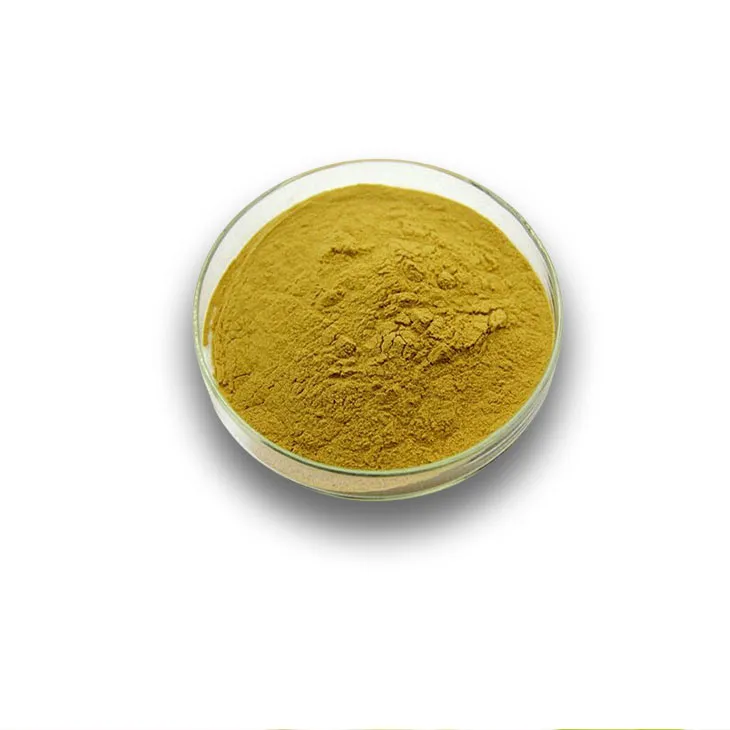- 0086-571-85302990
- sales@greenskybio.com
The process of extracting the effective components of honeysuckle from honeysuckle pollen.
2024-11-29

1. Introduction
Honeysuckle, a well - known traditional Chinese medicinal plant, has been widely used for its various pharmacological effects. Honeysuckle contains a rich variety of effective components, such as flavonoids, phenolic acids, and essential oils, which endow it with antioxidant, anti - inflammatory, antibacterial, and antiviral properties. Honeysuckle Pollen, as an important part of honeysuckle, also contains these valuable effective components. Extracting these components from Honeysuckle Pollen not only can make full use of the plant resources but also has great potential in the fields of medicine, health care products, and cosmetics.

2. Raw material collection and pretreatment
2.1 Collection
The collection of Honeysuckle Pollen is the first step in the extraction process. Honeysuckle pollen is usually collected during the flowering period of honeysuckle. It is crucial to ensure the purity of the pollen during the collection process. Only fully matured and healthy pollen should be collected. Manual collection can be carried out in small - scale production, while in large - scale production, mechanical collection devices can be used to improve efficiency.
2.2 Pretreatment
After collection, the honeysuckle pollen needs to be pretreated. The pretreatment mainly includes cleaning and drying.
- Cleaning: The collected pollen may be mixed with impurities such as dust, small flower fragments, and insects. Therefore, it needs to be carefully cleaned. Gentle washing with clean water can remove most of the surface impurities. However, it should be noted that excessive washing may cause the loss of some water - soluble components in the pollen.
- Drying: After cleaning, the pollen needs to be dried to reduce its moisture content. Drying can be carried out in a natural environment with good ventilation, but this method is time - consuming. In industrial production, drying equipment such as ovens or dryers is often used. The drying temperature should be controlled appropriately. Generally, a low - temperature drying method is preferred to avoid the destruction of effective components in the pollen due to high temperature.

3. Extraction methods
3.1 Solvent extraction
Solvent extraction is one of the commonly used methods for extracting effective components from honeysuckle pollen.
- Selection of solvents: Different solvents have different extraction effects on different effective components. For example, ethanol is a commonly used solvent. It has good solubility for flavonoids and phenolic acids in honeysuckle pollen. Ethyl acetate can also be used to extract some specific components. The choice of solvent needs to be based on the target effective components.
- Extraction process: After selecting the appropriate solvent, the pretreated honeysuckle pollen is added to the solvent at a certain ratio. For example, a solid - liquid ratio of 1:10 (pollen: solvent) can be used. Then, the mixture is placed in a shaking device or a stirred reactor and allowed to react for a certain period of time at a certain temperature. Usually, the extraction temperature can be set at room temperature to 60 °C, and the extraction time can range from 2 to 24 hours, depending on the nature of the solvent and the target components.
- Separation of the extract: After the extraction is completed, the mixture needs to be separated to obtain the extract containing the effective components. Filtration or centrifugation can be used for separation. Filtration can be carried out using filter paper or a filter membrane, while centrifugation can be carried out at a certain speed (such as 3000 - 5000 rpm) to separate the supernatant (extract) from the sediment (residue).
3.2 Supercritical fluid extraction
Supercritical fluid extraction is a relatively advanced extraction method with many advantages.
- Principle: Supercritical fluids have properties between gases and liquids. Carbon dioxide is the most commonly used supercritical fluid in the extraction of honeysuckle pollen. When carbon dioxide is in a supercritical state (above its critical temperature and pressure), it has high diffusivity, low viscosity, and strong solvency, which can effectively dissolve the effective components in honeysuckle pollen.
- Extraction process: The pretreated honeysuckle pollen is placed in the supercritical fluid extraction device. First, carbon dioxide is pressurized and heated to reach its supercritical state. Then, the supercritical carbon dioxide is passed through the pollen sample at a certain flow rate. The extraction process is affected by factors such as pressure, temperature, and extraction time. Generally, the extraction pressure can be set at 10 - 30 MPa, the extraction temperature at 30 - 60 °C, and the extraction time at 1 - 3 hours.
- Separation and collection: After the extraction is completed, the supercritical fluid containing the effective components is depressurized and cooled to separate the effective components. The separated carbon dioxide can be recycled for reuse. The obtained extract contains high - purity effective components.

4. Purification and concentration
4.1 Purification
The extract obtained from the extraction process may still contain some impurities, so purification is necessary.
- Column chromatography: Column chromatography is a common purification method. Different stationary phases (such as silica gel, alumina, etc.) can be selected according to the properties of the target components. The extract is loaded onto the column, and then different solvents are used for elution. Components with different polarities are eluted at different times, thereby achieving separation and purification.
- Membrane separation: Membrane separation technology can also be used for purification. Ultrafiltration membranes or nanofiltration membranes can be used to remove macromolecular impurities and small - molecule impurities respectively. For example, if the target is to purify flavonoids, ultrafiltration membranes can be used to remove proteins and polysaccharides in the extract.
4.2 Concentration
After purification, the extract usually needs to be concentrated to increase the content of effective components.
- Evaporation concentration: Evaporation is a simple and commonly used concentration method. The extract is heated under reduced pressure to evaporate the solvent, thereby increasing the concentration of the effective components. However, it should be noted that some heat - sensitive components may be damaged during the evaporation process.
- Freeze - drying concentration: Freeze - drying is a more gentle concentration method. The extract is first frozen and then placed in a vacuum environment to sublime the ice, leaving behind a concentrated product containing high - purity effective components. This method is suitable for heat - sensitive effective components.

5. Quality control and analysis during the extraction process
5.1 Quality control
Quality control is crucial throughout the extraction process to ensure the high quality of the final product.
- Raw material quality control: Before extraction, strict inspection of the quality of honeysuckle pollen should be carried out. This includes checking the purity, moisture content, and presence of contaminants. Only raw materials that meet the quality standards can be used for extraction.
- Process control: During the extraction, purification, and concentration processes, parameters such as temperature, pressure, time, and solvent ratio need to be closely monitored and controlled. Any deviation from the standard operating procedures may affect the quality of the final product.
- Final product quality control: After the extraction is completed, the final product needs to be comprehensively tested. Tests include determination of the content of effective components, detection of impurities, and evaluation of physical and chemical properties such as solubility and stability.
5.2 Analysis methods
Several analysis methods are used to monitor and evaluate the extraction process.
- High - performance liquid chromatography (HPLC): HPLC is widely used to analyze the content and purity of flavonoids, phenolic acids, and other components in the extract. It can accurately separate and quantify different components in the sample.
- Gas chromatography - mass spectrometry (GC - MS): GC - MS is mainly used to analyze the essential oils and volatile components in honeysuckle pollen. It can identify the chemical composition of these components and determine their relative contents.
- Spectrophotometry: Spectrophotometry can be used to quickly determine the total content of certain types of components, such as flavonoids. By measuring the absorbance of the sample at a specific wavelength, the content of the component can be calculated based on a pre - established standard curve.
6. Conclusion
The extraction of effective components from honeysuckle pollen is a complex but very promising process. Through proper raw material collection and pretreatment, selection of appropriate extraction methods, purification, and concentration, as well as strict quality control and analysis, high - quality extracts containing valuable effective components can be obtained. These extracts can be further developed into various products in the fields of medicine, health care products, and cosmetics, bringing more benefits to human health.
FAQ:
What are the main effective components in honeysuckle?
Honeysuckle contains various effective components, such as flavonoids, phenolic acids, and volatile oils. Flavonoids have antioxidant and anti - inflammatory properties. Phenolic acids also contribute to its pharmacological activities. Volatile oils give honeysuckle its characteristic fragrance and may have certain antibacterial effects.
Why is it important to extract effective components from honeysuckle pollen?
Extracting effective components from honeysuckle pollen is important for several reasons. Firstly, these components may have significant pharmacological activities, such as antibacterial, antiviral, and anti - inflammatory effects, which can be used in the development of new drugs. Secondly, it can help in the utilization of natural resources more effectively. Thirdly, it may provide alternatives to synthetic drugs with potentially fewer side effects.
What are the advantages of solvent extraction in the process of extracting effective components from honeysuckle pollen?
Solvent extraction has some advantages. It is a relatively simple and commonly used method. Different solvents can be selected according to the solubility characteristics of the target components. For example, polar solvents may be suitable for extracting polar effective components. It can also be carried out at relatively low cost and in a relatively mild reaction condition in some cases, which helps to preserve the activity of the extracted components.
How does supercritical fluid extraction work in extracting effective components from honeysuckle pollen?
In supercritical fluid extraction, a supercritical fluid, often carbon dioxide, is used. Supercritical carbon dioxide has properties between a gas and a liquid. It can penetrate into the honeysuckle pollen matrix well. By adjusting the pressure and temperature, the solubility of different components in the supercritical fluid can be controlled. This allows for the selective extraction of effective components. And after the extraction, the supercritical fluid can be easily removed by reducing the pressure, leaving the extracted components behind.
What are the key points in the purification step after extracting effective components from honeysuckle pollen?
The key points in the purification step include removing impurities such as pigments, proteins, and other unwanted substances. Chromatographic techniques can be used, for example, column chromatography can separate different components based on their different affinities to the stationary phase. Membrane filtration can also be applied to remove macromolecular impurities. The goal is to obtain highly pure effective components for further applications.
Related literature
- Extraction and Characterization of Bioactive Compounds from Honeysuckle"
- "Optimization of the Extraction Process of Honeysuckle Effective Components"
- "Supercritical Fluid Extraction of Active Ingredients from Honeysuckle Pollen: A Review"
- ▶ Hesperidin
- ▶ Citrus Bioflavonoids
- ▶ Plant Extract
- ▶ lycopene
- ▶ Diosmin
- ▶ Grape seed extract
- ▶ Sea buckthorn Juice Powder
- ▶ Fruit Juice Powder
- ▶ Hops Extract
- ▶ Artichoke Extract
- ▶ Mushroom extract
- ▶ Astaxanthin
- ▶ Green Tea Extract
- ▶ Curcumin
- ▶ Horse Chestnut Extract
- ▶ Other Product
- ▶ Boswellia Serrata Extract
- ▶ Resveratrol
- ▶ Marigold Extract
- ▶ Grape Leaf Extract
- ▶ New Product
- ▶ Aminolevulinic acid
- ▶ Cranberry Extract
- ▶ Red Yeast Rice
- ▶ Red Wine Extract
-
Berberis aristata Extract
2024-11-29
-
Mangosteen extract powder
2024-11-29
-
Scutellaria Extract
2024-11-29
-
Lycopene
2024-11-29
-
Coix Seed Extract
2024-11-29
-
Motherwort Extract
2024-11-29
-
Propolis Extract Powder
2024-11-29
-
Ivy Extract
2024-11-29
-
Grapefruit Seed Extract Powder
2024-11-29
-
Avocado Extract Powder
2024-11-29





















